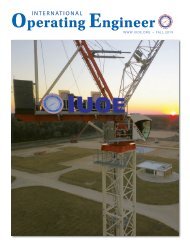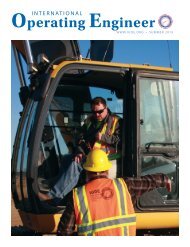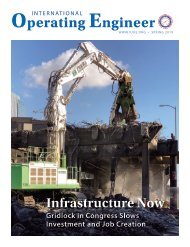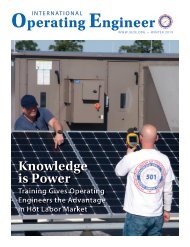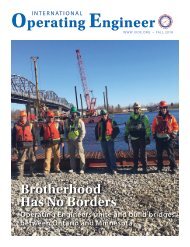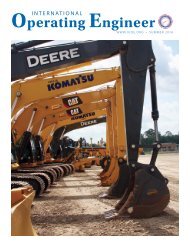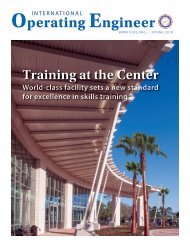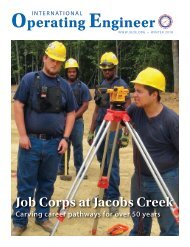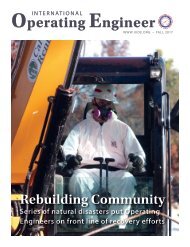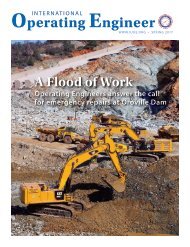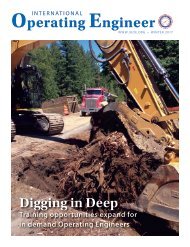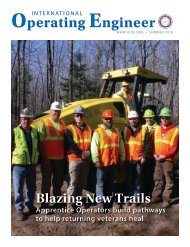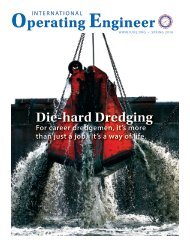125 Years Strong – An IUOE History
Celebrating the 125th Anniversary of the founding of the International Union of Operating Engineers
Celebrating the 125th Anniversary of the founding of the International Union of Operating Engineers
Create successful ePaper yourself
Turn your PDF publications into a flip-book with our unique Google optimized e-Paper software.
INTERNATIONAL UNION OF OPERATING ENGINEERS<br />
A pipeline class at the I.T.E.C.<br />
Making Training a Union-Wide Priority<br />
Highlighting the I.U.O.E.’s accelerated emphasis on training<br />
during the administration of General President Frank Hanley<br />
from 1990 into 2005 was the opening of the I.U.O.E. Southern<br />
Apprenticeship and Training Center at Yellow Creek in northeast<br />
Mississippi in September 1996. The center would serve as a<br />
comprehensive training facility for I.U.O.E. apprentices and journeylevel<br />
members of locals in the southern region of the United States,<br />
providing them with training to operate the latest construction<br />
equipment as well instruction in fields such as hazardous materials<br />
handling and asbestos abatement.<br />
The union took another major stride in the presentation of<br />
its training and education initiatives in December 1997 when it<br />
converted several equipment-training programs to a CD-ROM<br />
format, thereby taking maximum advantage of new technology to<br />
make the teaching aspect of training more effective and on-target,<br />
and the learning aspect more stimulating and simple. The CD-<br />
ROM format allowed I.U.O.E. instructors more flexibility in steering<br />
the direction of the training, which resulted in trainees receiving the<br />
information they required more quickly.<br />
Then, in perhaps one of the more significant developments<br />
for the union’s training during that time, in 2000 the I.U.O.E. and<br />
the Department of Labor’s Bureau of Apprenticeship and Training<br />
developed revised guidelines for teaching heavy-equipment<br />
apprentices and revised apprentice-selection procedures to more<br />
accurately reflect changing trends in the industry, as well as the<br />
economic situations of the time. Among its provisions, the new<br />
Apprenticeship Guidelines for the Joint Apprenticeship Training<br />
Committee decreased on-the-job training hours from a minimum<br />
of 6,000 hours to a minimum of 4,000 hours; redefined the<br />
ratio of apprentices to journey workers as no more than one<br />
apprentice for every five journey-level workers; reduced the<br />
amount of classroom-based, related-studies hours to reflect the<br />
hours of field training; allowed credit for previous experience at the<br />
trade; and added three membership “direct entry” classifications:<br />
apprenticeable military, apprenticeable Job Corps and members<br />
signed on through organizing.<br />
The Department of Labor’s Office of Apprenticeship Training,<br />
Employer and Labor Services formally approved and certified<br />
the new guidelines during a ceremony at I.U.O.E. headquarters in<br />
Washington, D.C., on January 4, 2001. The Equal Employment<br />
Opportunity Commission also ratified the new procedures.<br />
Yet another key accomplishment took place in 2006 when the<br />
union established its National Training Fund to serve as an umbrella<br />
organization for all I.U.O.E. training programs, coordinating policies,<br />
strategies and activities with extensive support and input from its<br />
locals. Notably, the fund would provide a broad range of safety and<br />
health training for the union’s membership and instructors, which<br />
would eventually include the union’s National HAZMAT Program<br />
for the safe, proper handling of hazardous materials.<br />
Equipping the Union for Future Success<br />
By 2017, the I.U.O.E. had in place for many years an<br />
extensive infrastructure of local training facilities, equipment and<br />
learning resources that continue to form the backbone of its craft<br />
instruction. But in July of that year, the union began construction<br />
on a definitive tool in its training arsenal: the I.U.O.E. International<br />
Training and Education Center near Houston.<br />
Built on 265 acres mostly purchased by the union in 2014<br />
in anticipation of a massive construction boom in the Gulf Coast<br />
region, and especially in the oil-and-gas sector, the facility serves<br />
the union’s Hoisting & Portable, Stationary and Petrochemical<br />
branches and set the training standard in that region. “Our goal<br />
is to build a training center that takes the best attributes of all<br />
the outstanding programs developed throughout the international<br />
and amass them in a southern location in order to capture the<br />
upcoming development opportunities,” I.U.O.E. General President<br />
James T. Callahan had announced in the Spring 2014 International<br />
Operating Engineer journal.<br />
Designed with the help of a blue-ribbon panel of local I.U.O.E.<br />
training coordinators from across the United States and Canada,<br />
the state-of-the-art, world-class Training and Education Center<br />
opened in April 2018 as the largest and most comprehensive<br />
training facility for union operating and stationary engineers in North<br />
America. It was specifically developed to advance and improve the<br />
skills of the union’s members, instructors and staff throughout the<br />
country to better meet the needs of the construction industry by<br />
augmenting and enhancing the training programs administered by<br />
the union’s locals.<br />
The center provides the means to host, support and<br />
develop the skills of a constantly expanding and varied group<br />
of construction and maintenance professionals. It<br />
includes an 8,120-square-foot conference space;<br />
17 classrooms and labs; a 15-pad crane field;<br />
equipment simulator rooms; a heavy-equipment<br />
mechanics shop; welding bays; a central utility plant<br />
with training redundancies; a 227-room dormitory;<br />
a fitness center; and full dining facilities. Its ample<br />
outdoor space is used to conduct pipeline training,<br />
crane training and heavy-equipment operations.<br />
“This state-of-the-art facility demonstrates our<br />
union’s commitment to high-quality training to our<br />
signatory contractors, general contractors and<br />
owners,” an article in the Winter 2017 International<br />
Operating Engineer declared.<br />
Stationary Training and Trust<br />
GROWING A PETRO-<br />
CHEMICAL WORKFORCE<br />
As the I.U.O.E. moved into 2020 and towards its<br />
<strong>125</strong> th year in 2021, the union was annually investing<br />
over $180 million in training, while its locals were<br />
sponsoring 100 apprenticeship and training programs<br />
Additional developments included the early-2009 launch<br />
at 127 training sites throughout North America. With<br />
A training simulator for machine operation at the I.T.E.C. of the union’s Blackboard Learning System, an online training<br />
1,000 instructors and thousands of acres dedicated A wind turbine maintenance class at Local 150.<br />
clearinghouse and course-delivery platform.<br />
to training throughout North America, the union’s<br />
The new I.U.O.E. Stationary Engineer Apprentice Training<br />
and Trust (SEATT) graduated its first class of operators in<br />
early 2016 at Western Refining in El Paso, Texas, after six<br />
weeks of intensive training. SEATT was formed to work with<br />
participating employers to establish a highly skilled pool of<br />
future petro-chemical operators.<br />
For that initial course, SEATT recruited experienced<br />
operators from the refinery to instruct the students in topics<br />
that petro-chemical operators needed to be safe, efficient and<br />
productive. Classes addressed subjects ranging from basic<br />
hand tools to valves, boilers, reactors, distillation, turbines,<br />
compressors, instrumentation, furnaces, cooling towers, heat<br />
exchangers, physics, chemistry, safe work permitting and hot<br />
work permitting, as well as various other topics.<br />
members have access to training on virtually every topic heavyequipment<br />
operators and stationary engineers require.<br />
Over the years, the comprehensive training programs the<br />
I.U.O.E. has developed and maintained have become widely<br />
recognized as the best in a number of industries <strong>–</strong> and allow the<br />
union to fulfill its ongoing mission: To provide highly skilled, safe and<br />
productive heavy-equipment operators and facilities engineers to<br />
the construction, pipeline, stationary and environmental industries.<br />
LABOR OMNIA VINCIT<br />
WORK CONQUERS ALL



